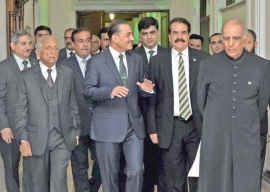
In the remote Seo Tehsil of K-P's Upper Kohistan District, a routine journey turned into a fatal plunge when a makeshift chairlift collapsed into the raging Indus River. The tragedy claimed the lives of three men who were simply trying to make their way back home. Imagine relying on a rickety, manually operated cable car to cross a river, knowing full well that its foundations have been weakened by recent floods. For many in the rugged terrains of K-P and Gilgit-Baltistan, this is a daily reality.
Just last month, another heartbreaking story unfolded when a father drowned while trying to rescue his son from a malfunctioning chairlift. And who can forget last year's nerve-wracking episode in Battagram, where eight people, including six children, were left hanging over a deep ravine after their cable car's wires snapped? It is a pattern that repeats itself far too often and brings to light a much larger issue of shoddy infrastructure in remote areas. The chairlift in Seo Tehsil fell because its foundations crumbled under the pressure of a swollen river. But in truth, it collapsed under the weight of decades of neglect and poor planning. The lack of proper maintenance and oversight in these areas is a ticking time bomb, and the fact that every day it remains unchecked is a gamble with human lives.
It is not enough to blame the challenging topography or the weather. The real issue is a failure to invest in durable, reliable infrastructure that can withstand the harsh conditions of these regions. The makeshift solutions currently in place are accidents waiting to happen. There needs to be a national strategy for upgrading infrastructure in remote regions. This strategy should include not only new construction projects but also a comprehensive review of existing infrastructure. The goal should be to prevent tragedies like the one in Seo Tehsil from ever happening again.






1723807223-0/jimin-(1)1723807223-0-270x192.webp)







COMMENTS
Comments are moderated and generally will be posted if they are on-topic and not abusive.
For more information, please see our Comments FAQ